
Note from Taylor Reaume: Dr. Marshall Rosenberg is one of my top 10 mentors. I was privileged to have the opportunity to meet him twice at workshops held in Santa Barbara. His model for compassionate communication is the most advanced and helpful system for processing internal thoughts I have ever found.
With a nation often on edge due to political and racial strife, students and communities trying to make their voices heard, and even families forced to quarantine together in close quarters, it has never been more important to learn to communicate without resorting to violence. Nonviolent Communication, or NVC, heightens awareness regarding the importance of communicating compassionately, verbalizing feelings, and understanding the differences between needs and requests vs. demands. I hope you enjoy these insights into his work.
A Worldwide Movement Begins
Dr. Marshall Rosenberg was an American psychologist, mediator, author and teacher known for developing the theory of Nonviolent Communication. He began formulating his insights during the civil rights and anti-war protests of the 1960s, and helped to peacefully desegregate long-separated school districts. From there, he went on to work as a global peacemaker and founded the Center for Nonviolent Communication (CNVC), an international non-profit organization. The NVC community is currently active in over 65 countries around the globe. According to the Center:
“NVC is based on the principles of nonviolence – the natural state of compassion when no violence is present in the heart. NVC begins by assuming that we are all compassionate by nature and that violent strategies—whether verbal or physical—are learned behaviors taught and supported by the prevailing culture.”
NVC assumes that we all share the same, basic human needs, and that all actions are a strategy to meet one or more of these needs. People who practice NVC have found greater authenticity in their communication, increased understanding, deeper connections, and enhanced conflict resolution. Applications can be seen in all sectors of society from the personal and professional to the political.
Groups such as educators, mental health and health care providers, managers, lawyers, police and prison officials, military officers, prisoners, clergy, government officials, and families have benefited from his teachings. He has provided training to promote the peaceful resolution of differences in areas fraught with war and economic disadvantages.
What is NVC?
Most of us want to improve the quality of our relationships, to deepen our sense of personal empowerment and to communicate more effectively. Unfortunately, though, we have been educated from birth to compete, judge, demand and diagnose; to think and communicate in terms of “right“ and “wrong.“ The habitual ways we think and speak tend to hinder communication and create misunderstanding. At their most extreme, our unfeeling habits can lead to anger, pain, and even violence.
NVC reaches beneath the surface and discovers what is alive and vital within us. It flows from the understanding that all of our actions are based on human needs we seek to fulfill. NVC provides a vocabulary of feelings and needs that help us more clearly express what is going on in us, and understand what is going on in others. When we understand and acknowledge our needs, we develop a shared foundation for much more satisfying relationships.
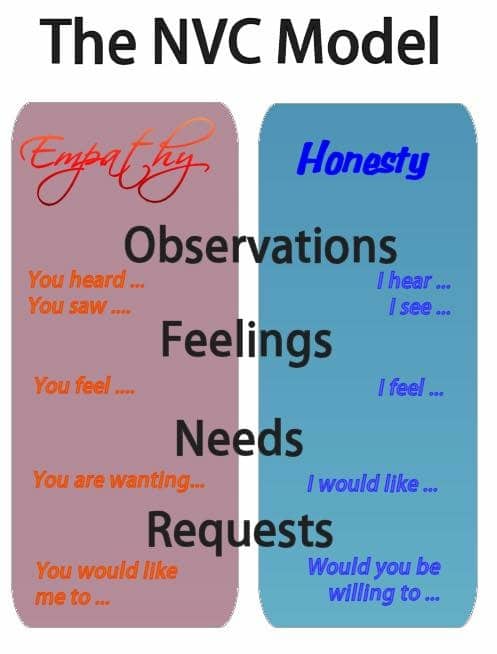
Violent Communication vs. Nonviolent Communication
In its Key Facts About Nonviolent Communication, the CNVC describes violence as “acting in ways that result in hurt or harm.” Based on this definition, they believe that much of how we communicate – judging others, bullying, having racial bias, blaming, finger pointing, discriminating , speaking without listening, criticizing others or ourselves, name-calling, reacting when angry, using political rhetoric, being defensive or judging who’s “good/bad” or what’s “right/wrong” with people – could therefore be called “violent communication.”
Nonviolent Communication, on the other hand is the integration of four things:
- Consciousness: a set of principles that support living a life of compassion, collaboration, courage, and authenticity.
- Language: understanding how words contribute to connection or distance.
- Communication Skills: knowing how to ask for what we want, how to hear others even in disagreement, and how to move towards solutions that work for all.
- Means of Influence: sharing “power with others” rather than using “power over others.”
NVC serves our desire to increase our ability to live with choice, meaning, and connection; connect empathically with self and others to have more satisfying relationships; and share resources so everyone is able to benefit.
The Four Cornerstones of NVC
Most workshops, prior to Dr. Rosenberg’s time, tended to focus on conflict resolution as gaining power over other people. There was no recognition of individual qualities or affirmation of each other’s uniqueness, no compassion or nurturing. While violence usually results from such concepts as judgments, thoughts, strategies and demands, Rosenberg instead based NVC on four core components known as OFNR:
- Observations: This is a description of what is actually happening, as reported by our direct, sensory experiences mixed with our “inner voice.” Observations should be free of moral judgment and criticism.
- Feelings: These are the physical sensations and emotions which are universal to all people. It could be a sensation of fear, love, happiness, or guilt.
- Needs/Values: These are the resources which are necessary to sustain our lives, and are also universal.
- Requests: Requests are when one party has an opportunity to contribute to the well-being of another. It is a specific action which provides a concrete offering with the intention of helping to fulfill a need. Requests can come in the form of clarity, feedback and action.
How You Can Use the NVC Process
The life-changing benefits of NVC can be applied to conflict resolution, personal relationships, parenting and families, education, personal growth, organizational effectiveness, anger management, business relationships and individual spirituality.
NVC helps to develop your emotional vocabulary, connect with your feelings and needs, break negative habit patterns, hear the needs behind behavior and get to the heart of the conflict.
A good starting point is to learn how to use “feeling” words in a sentence. This way you can accurately describe how you are feeling to the other person.
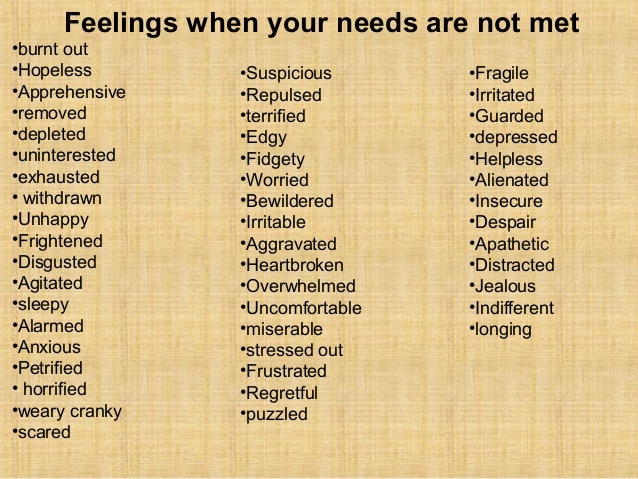
Getting both people’s needs met involves accurately communicating how one feels about the needs being met or unmet.

Here is a general outline of the entire communication model:
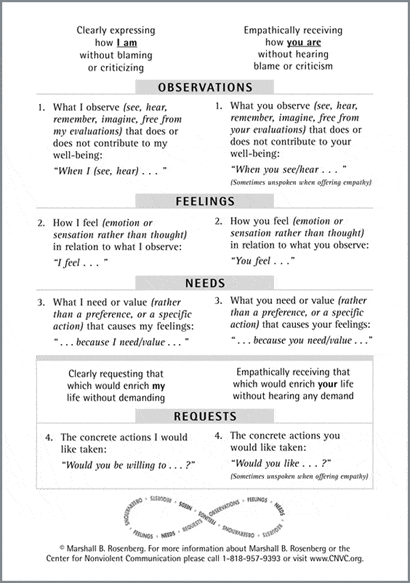
Paraphrased Quotes from Dr. Marshall B. Rosenberg
“Every criticism, judgment, diagnosis, and expression of anger is the tragic expression on an unmet need.”
“The goal of Nonviolent Communication is not to alter people and their behavior to suit us; it is to establish relationships based on empathy and honesty, which will fulfill everyone’s needs eventually.”
“The more we discuss the past, the less we heal from it.”
“We can’t make anyone do anything against their will without enormous consequences.”
Below is a Youtube video of Dr. Marshall Rosenberg speaking to a group of psychologists. This was an NVC workshop in San Francisco, CA.
Although Dr. Rosenberg passed away in 2015, the Center he founded continues to educate people to communicate more effectively and become more connected globally. The world is definitely in a better place for the legacy he left us.
NVC QUIZ FOR KIDS: I stayed up until 4am designing these quiz sheets below. If you have kids, you might benefit from chatting with them about the answers.
I use these quizzes to annoy the crap out of my nephews and nieces when I see them. 🙂
They are designed to help children distinguish between feelings or thoughts, and requests or demands.
And finally, below is a collection of infographics I’ve collected over the years.









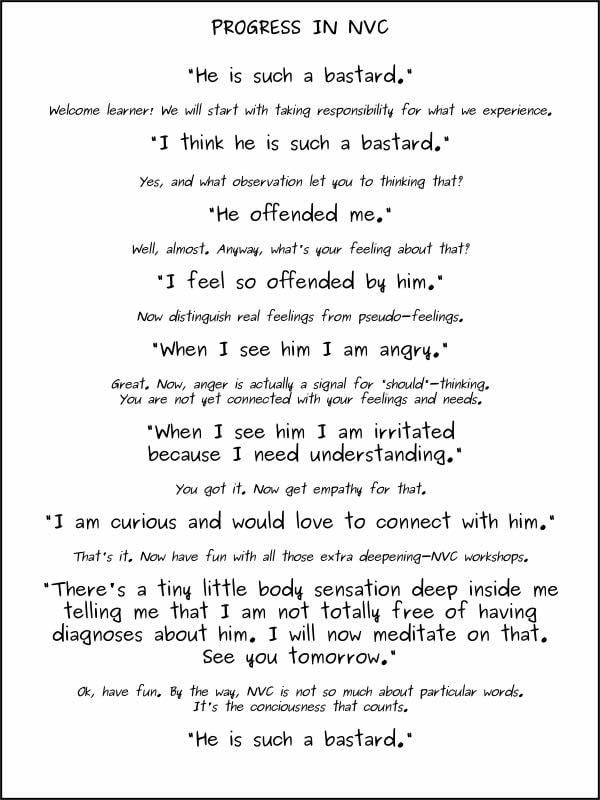

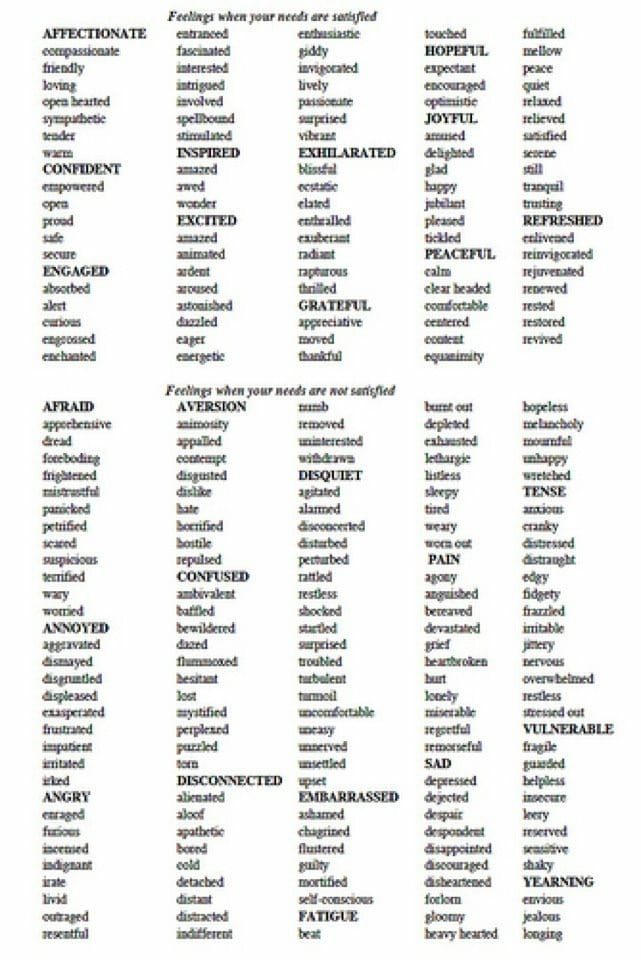
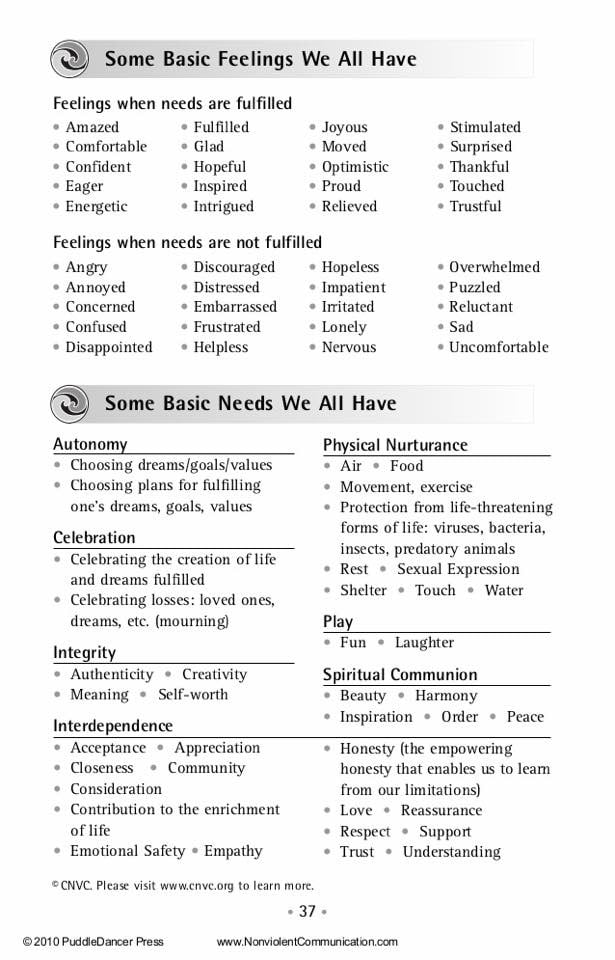
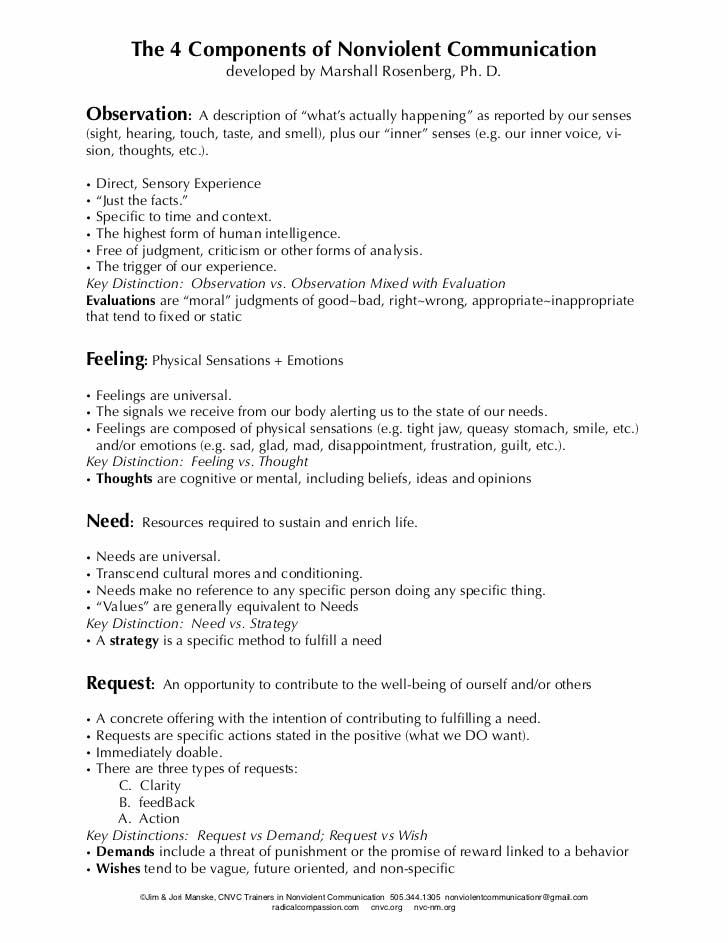
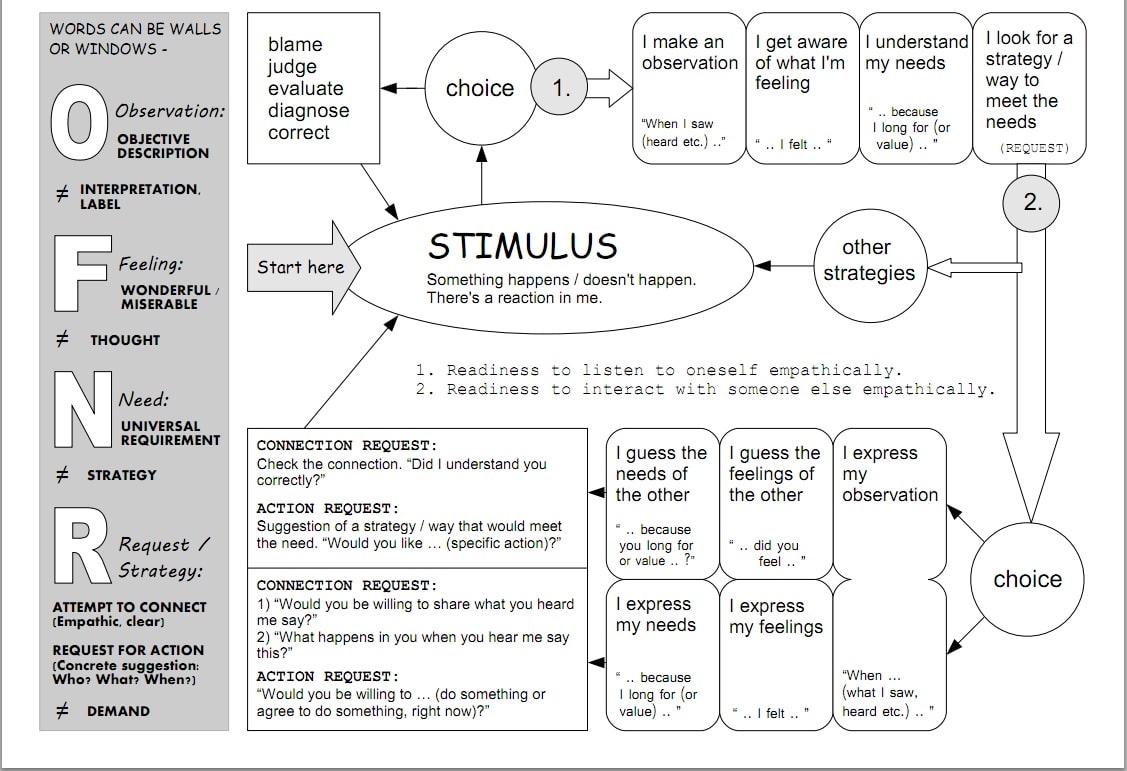

Thanks for sharing this experience, lucky you to have him as your mentor. Social Media has been quite toxic nowadays; despite having to serve as a seamless platform for communication, it has indeed created a medium as well for arguments and demarcation lines between communities. Practicing the key principles of Non-Violent Communication can certainly provide a purview on the needed strategies we can impose on ourselves to create a safe place for everyone to communicate without having to condescend to the opinions of other people. I personally think this should be shared more across the academe and even through all educational pedagogies, having to equip our younger generation for better communication skills within the virtual world.
Taylor, thank you for sharing your mentor and his thoughts with us. It has been noted by experts that in today’s time there has never been so much polarization between people. Not only are ideas and cultures pitting people at separate ends the way these things are communicated adds to the turmoil. Now is as great a time as any to revisit this amazing theory of nonviolent communication developed by your mentor. He too was during a time of Great War and polarization and such great social change and found a way to bring people together and the center humanity in them all. Currently, I am finishing up school to receive my human services degree and my communication course went over his teachings. Assuming positive intent, or as you put it compassion in each other truly helps approach the situation with open minds and hearts. Our teacher truly challenged us to utilize the NVC principles not just when working with future clients but in our homes with spouses, our children and even our good friends. The world could definitely use more everyday reminders on what it means to communicate using consciousness, connecting language, and sharing power while asking for what we want.
Hello Taylor,
You sound like Dr. Rosenberg powerfully influenced in your life.
You draw out the idea we’re all taught to some less than effective communication methods from those who have gone before us. Our current political and racial climate is a good example of how the old ways of communication don’t work.
Dr. Rosenberg’s NVC is a way of communicating we all need to learn. I have long tried to use I statements in my communication to state my feelings and let go of the outcome. The characterizations of needs and requests teaches us all this valuable distinction.
Your blog about Dr. Rosenberg has me seeking out and reading more of this wise man’s work.”
Warm smiles, Elizabeth K
Hey Taylor, you’re lucky to have had such a kind and thoughtful mentor. The last year has been difficult with disagreements on politics during the election, frustration over the handling of the pandemic, and anger over racial injustices. I think that NVC principles would have been beneficial in these instances where different parties often struggled to find common ground to work towards solutions. NVC strategies could be useful in trying to have an open dialogue with someone where you seek to understand how to meet their needs and concerns rather than just trying to gain the upper hand over them.
Hi Taylor
Thank you for this article on nonviolent communication. It seems at this time learning how to communicate effectively is needed now more than ever. If you watch the news, read Facebook or any other social media sites you see so many people communicating in a judgmental way with a lot of bullying. I often wonder if this would be the case if this type of behavior has became worse with the lack of face to face communication.
It is much easier to blame the other person for our feelings instead of making I statements. Even when making I statements the other person can feel they are being accused of something and want to judge and convince the person they are wrong. Most of us have the need to always be right, I know I do at times, I am trying to learn it is okay to tell others I was wrong and they were right. I do hate admitting that at times though.
Hey Taylor, what a phenomenal mentor to have! There seems to be a drought when it comes to compassionate communication these days. In my industry especially, people are on the attack. It is important to listen and empathize with others, especially if you are the face of company. Responding to negative reviews with accusations or hateful words can leave a lasting mark on your company. When you truly listen to the person, even a negative review can be helpful. That is why I always try to find a way to relate to the person rather than respond with a violent heart. More people want to work with you when they find that you care about what they say. Communicate with good intentions.
I was fortunate enough to be introduced to Dr. Marshall Rosenberg’s NVC theories while studying business at FSU. I wish all professors were familiar with his work and approaches, as it could do the world a huge favor. People are so full of hate in these modern times, whether it’s provoked or just simply their way of expressing how they are feeling.
I believe the biggest problem we face as a nation is encouraging people to say whatever is on their minds – if only people would think before speaking, we might live in a kinder world.
As someone who’s studied communication in college, this is very interesting, as I have never heard of Dr. Marshall, but am familiar with this style of verbal practice. I’ve noticed similar style methods used by mediators to keep attacks from happening between the various parties. I was always taught that when there’s a problem, you should always leave in and come back to it when you are less angry. While I think it’s an amazing and useful practice, I do think that is a little incorrect to say that violent communication is the product of how we are taught to behave. Instead I think it has more to do with how humans experience emotion.
As someone who has studied different ways of communication so that I can be the best mom I can be someday, this idea of nonviolent communication intrigues me. You’re right that a lot of the time violence comes from learned behavior or is a trauma response. I want to teach my kids how to identify and understand their emotions. As a child, I was often told “because I said so” and “sit down and shut up”. Children who were brought up this way certainly have a lot of trauma to work through as an adult. They have to relearn how to communicate, and I have had to do this for years now. I have made some wonderful progress and I hope to pass this on to my children as well.
This article was great and really touched on what is wrong with this new way of life society is becoming accustomed to. People just want to be heard, listened to and not be criticized for their feelings. The information shared in this article could really have anyone take a look at their own compassion and reevaluate reactions that they themselves may not have been open to before, or never even knew about. After all, it’s no secret to know that built up, never addressed feelings, of any kind, good or bad can or will fester into violent communication, instead of NVC. When someone is going through unidentified emotions, feelings and doesn’t understand how to release them, instead of repressing their feelings, or sharing them only to find they were not heard and no solution is in the works, some pretty terrible things can happen. This article on non violent communication and what steps to take to get to a solution can make a worldly difference for even just one individual. I think everyone can learn something from NVC, after all being heard, listened to and having someone empathize with another can make a world of a difference. Every person is a human being with needs that need to be met and the NVC approaches Dr. Marshall has explained, is a great way to communicate, whether it be in a work, home or a social setting, the NVC approach would benefit everyone in some way.
So cool that you were able to have this gentleman as your mentor! And countless number of people these days could have a lot to learn from these concepts. Social media combined with divided views on issues are unfortunately shifting our language in the opposite direction. I appreciated how you presented specific ideas and examples that we can use in our own communication, as well as the quiz sheets for kids. Children are the most impressionable of all people and our communication and our words really do matter!
Taylor,
I appreciate you for sharing this experience. Nonviolent communication should be common in our society. Particularly on social media, where everyone seems to post nasty messages to each other. Dr. Michael Rosenberg’s theories were very informative and interesting. He seemed like a great person and it’s unfortunate that he is not still with us, but his messages can still be handed down. The NVC quizzes and infographics seem like they could be useful and a learning tool for kids. The younger generation could benefit from this type of learning. Thank you for this post, Taylor.
We need more doctors like this around. I can’t help but login to Facebook or Twitter anymore and see people completely bashing total strangers. I don’t think people process their internal thoughts and actually realize what they are saying in a public forum sometimes. I had a mentor one time and he kept it pretty basic for me. He told me to always think first before you say anything. And make sure it is beneficial to the other person. We seem to lack a genuine respect for each other anymore. Glad to see you got an opportunity to meet someone that coaches in things such as these.
I also struggle with my communication skills most of the time. I always felt the urge to win over an argument or show to them that I am right. Hence, I sometimes resort to my temper, leading me to utter words that I would soon regret. Thank you for sharing the NVC with us. I definitely learned something I would apply in my life.
Good job on the designs of NVC quiz sheets for the children. It’s true that we should be able to teach children to differentiate a feeling and a thought for them to practice proper communication skills.